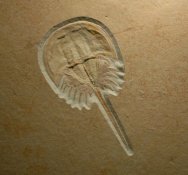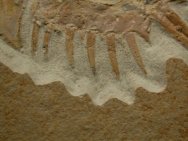Mesolimulus walchi
Phylum Arthropoda, Subphylum Chelicerata, Class, Merostomata, Order Xiphosura
Geologic Time: Late Jurassic, Kimmeridgian Stage (~ 150 million years ago)
Size: 175 mm long
Fossil Site: Solnhoen Limestone Lagerstätte, Malm Zeta 2, Eichstatt, Bavaria, Germany
Because they have ostensibly changed little over some 485 million years, extant horseshoe crabs are often considered by some to be so-called living fossils. They were highly diverse during the Palaeozoic Era, although extant genera number but three, with but five species remaining. Horseshoe crabs possess a large shield covering their cephalothorax, and a carapace that is hinged between the cephalothorax and the abdomen. A strong exoskeleton has three parts, the large semicircular cephalothorax, the opisthosoma that is the posterior portion of body behind the cephalothorax, and a long tail spine (telson). The trilobite-like morphology is apparent, and some scientists consider Xiphosura to be the closest living relative of trilobites. Also
see: Solnhofen Fossils |









